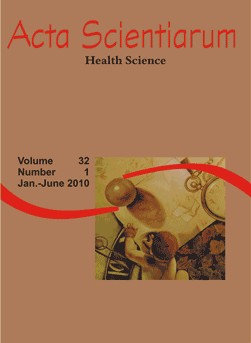<b>Film products - Innovation in cosmetics technology. The cosmetics industry has invested heavily in the research and development of new products, to satisfy consumer demands</b> - DOI: 10.4025/actascihealthsci.v32i1.6987
Keywords:
cosmetics in film, polysaccharide, vegetable extracts
Abstract
As a result of the innovation in this sector, cosmetics have emerged in film format. Starting from an initial formula containing a polysaccharide consisting of maltotriose units as a film former and sodium polyacrylate as gelling agent, viscous gels were obtained and dispersed in glass plate, in order to obtain 1 mm thick films. After drying to room temperature, they were cut out (1 cm2) and conditioned. Various alterations were carried out in order to obtain a film with good flexibility, adequate rigidity, without cracks and bubbles, easy dissolution in water and a pleasant feel. The formulations were submitted to different temperatures, for preliminary evaluation of their stability. Two products were developed: one containing hydroglicolic extracts from aloe vera and white rose, auxiliaries in the treatment of acne, and another containing hydroglicolic extracts from chamomile and of pear, used to combat dark circles under the eyes. Small, light and thin, film cosmetics are an innovation that can take the place of traditional products, as they offer greater practicality and ease of use and transport, maintaining the effectiveness and safety necessary for cosmetics.Downloads
Download data is not yet available.
Published
2009-12-07
How to Cite
Sanfelice, A. M., & Truiti, M. da C. T. (2009). <b>Film products - Innovation in cosmetics technology. The cosmetics industry has invested heavily in the research and development of new products, to satisfy consumer demands</b> - DOI: 10.4025/actascihealthsci.v32i1.6987. Acta Scientiarum. Health Sciences, 32(1), 61-66. https://doi.org/10.4025/actascihealthsci.v32i1.6987
Issue
Section
Pharmacy
DECLARATION OF ORIGINALITY AND COPYRIGHTS
I Declare that current article is original and has not been submitted for publication, in part or in whole, to any other national or international journal.
The copyrights belong exclusively to the authors. Published content is licensed under Creative Commons Attribution 4.0 (CC BY 4.0) guidelines, which allows sharing (copy and distribution of the material in any medium or format) and adaptation (remix, transform, and build upon the material) for any purpose, even commercially, under the terms of attribution.
Read this link for further information on how to use CC BY 4.0 properly.























5.png)







